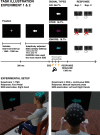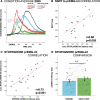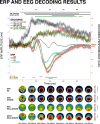Common and Unique Inhibitory Control Signatures of Action-Stopping and Attentional Capture Suggest That Actions Are Stopped in Two Stages
- PMID: 34493541
- PMCID: PMC8528501
- DOI: 10.1523/JNEUROSCI.1105-21.2021
Common and Unique Inhibitory Control Signatures of Action-Stopping and Attentional Capture Suggest That Actions Are Stopped in Two Stages
Abstract
The ability to stop an already initiated action is paramount to adaptive behavior. Much scientific debate in the field of human action-stopping currently focuses on two interrelated questions. (1) Which cognitive and neural processes uniquely underpin the implementation of inhibitory control when actions are stopped after explicit stop signals, and which processes are instead commonly evoked by all salient signals, even those that do not require stopping? (2) Why do purported (neuro)physiological signatures of inhibition occur at two different latencies after stop signals? Here, we address both questions via two preregistered experiments that combined measurements of corticospinal excitability, EMG, and whole-scalp EEG. Adult human subjects performed a stop signal task that also contained "ignore" signals: equally salient signals that did not require stopping but rather completion of the Go response. We found that both stop- and ignore signals produced equal amounts of early-latency inhibition of corticospinal excitability and EMG, which took place ∼150 ms following either signal. Multivariate pattern analysis of the whole-scalp EEG data further corroborated that this early processing stage was shared between stop- and ignore signals, as neural activity following the two signals could not be decoded from each other until a later time period. In this later period, unique activity related to stop signals emerged at frontocentral scalp sites, reflecting an increased stop signal P3. These findings suggest a two-step model of action-stopping, according to which an initial, universal inhibitory response to the saliency of the stop signal is followed by a slower process that is unique to outright stopping.SIGNIFICANCE STATEMENT Humans often have to stop their ongoing actions when indicated by environmental stimuli (stop signals). Successful action-stopping requires both the ability to detect these salient stop signals and to subsequently inhibit ongoing motor programs. Because of this tight entanglement of attentional control and motor inhibition, identifying unique neurophysiological signatures of action-stopping is difficult. Indeed, we report that recently proposed early-latency signatures of motor inhibition during action-stopping are also found after salient signals that do not require stopping. However, using multivariate pattern analysis of scalp-recorded neural data, we also identified subsequent neural activity that uniquely distinguished action-stopping from saliency detection. These results suggest that actions are stopped in two stages: the first common to all salient events and the second unique to action-stopping.
Keywords: EEG; EMG; attentional capture; inhibitory control; motor inhibition; stop signal task.
Copyright © 2021 the authors.
Figures





Similar articles
-
Perceptual Surprise Improves Action Stopping by Nonselectively Suppressing Motor Activity via a Neural Mechanism for Motor Inhibition.J Neurosci. 2018 Feb 7;38(6):1482-1492. doi: 10.1523/JNEUROSCI.3091-17.2017. Epub 2018 Jan 5. J Neurosci. 2018. PMID: 29305533 Free PMC article.
-
Examining motor evidence for the pause-then-cancel model of action-stopping: insights from motor system physiology.J Neurophysiol. 2024 Nov 1;132(5):1589-1607. doi: 10.1152/jn.00048.2024. Epub 2024 Oct 16. J Neurophysiol. 2024. PMID: 39412561
-
Neural Architecture of Selective Stopping Strategies: Distinct Brain Activity Patterns Are Associated with Attentional Capture But Not with Outright Stopping.J Neurosci. 2017 Oct 4;37(40):9785-9794. doi: 10.1523/JNEUROSCI.1476-17.2017. Epub 2017 Sep 8. J Neurosci. 2017. PMID: 28887387 Free PMC article.
-
The Pause-then-Cancel model of human action-stopping: Theoretical considerations and empirical evidence.Neurosci Biobehav Rev. 2021 Oct;129:17-34. doi: 10.1016/j.neubiorev.2021.07.019. Epub 2021 Jul 19. Neurosci Biobehav Rev. 2021. PMID: 34293402 Free PMC article. Review.
-
Does the stop-signal P3 reflect inhibitory control?Cortex. 2025 Feb;183:232-250. doi: 10.1016/j.cortex.2024.12.005. Epub 2024 Dec 21. Cortex. 2025. PMID: 39754857 Review.
Cited by
-
The influence of emotional feedback material type on attentional capture at different presentation times.PLoS One. 2024 Sep 16;19(9):e0310022. doi: 10.1371/journal.pone.0310022. eCollection 2024. PLoS One. 2024. PMID: 39283871 Free PMC article.
-
Inhibitory control of speech production in the human premotor frontal cortex.Nat Hum Behav. 2025 May;9(5):971-986. doi: 10.1038/s41562-025-02118-4. Epub 2025 Mar 3. Nat Hum Behav. 2025. PMID: 40033133
-
Motor inhibition errors and interference suppression errors differ systematically on neural and behavioural features of response monitoring.Sci Rep. 2024 Jul 10;14(1):15966. doi: 10.1038/s41598-024-66364-8. Sci Rep. 2024. PMID: 38987364 Free PMC article.
-
Common and unique neurophysiological signatures for the stopping and revising of actions reveal the temporal dynamics of inhibitory control.bioRxiv [Preprint]. 2024 Jun 22:2024.06.18.597172. doi: 10.1101/2024.06.18.597172. bioRxiv. 2024. Update in: J Neurosci. 2025 Mar 26;45(13):e1537242025. doi: 10.1523/JNEUROSCI.1537-24.2025. PMID: 38948849 Free PMC article. Updated. Preprint.
-
Examining motor evidence for the pause-then-cancel model of action-stopping: Insights from motor system physiology.bioRxiv [Preprint]. 2024 Jan 30:2024.01.30.577976. doi: 10.1101/2024.01.30.577976. bioRxiv. 2024. Update in: J Neurophysiol. 2024 Nov 1;132(5):1589-1607. doi: 10.1152/jn.00048.2024. PMID: 38352621 Free PMC article. Updated. Preprint.
References
-
- Benjamini Y, Hochberg Y (1995) Controlling the false discovery rate: a practical and powerful approach to multiple testing. J R Stat Soc B 57:289–300. 10.1111/j.2517-6161.1995.tb02031.x - DOI
Publication types
MeSH terms
Grants and funding
LinkOut - more resources
Full Text Sources
